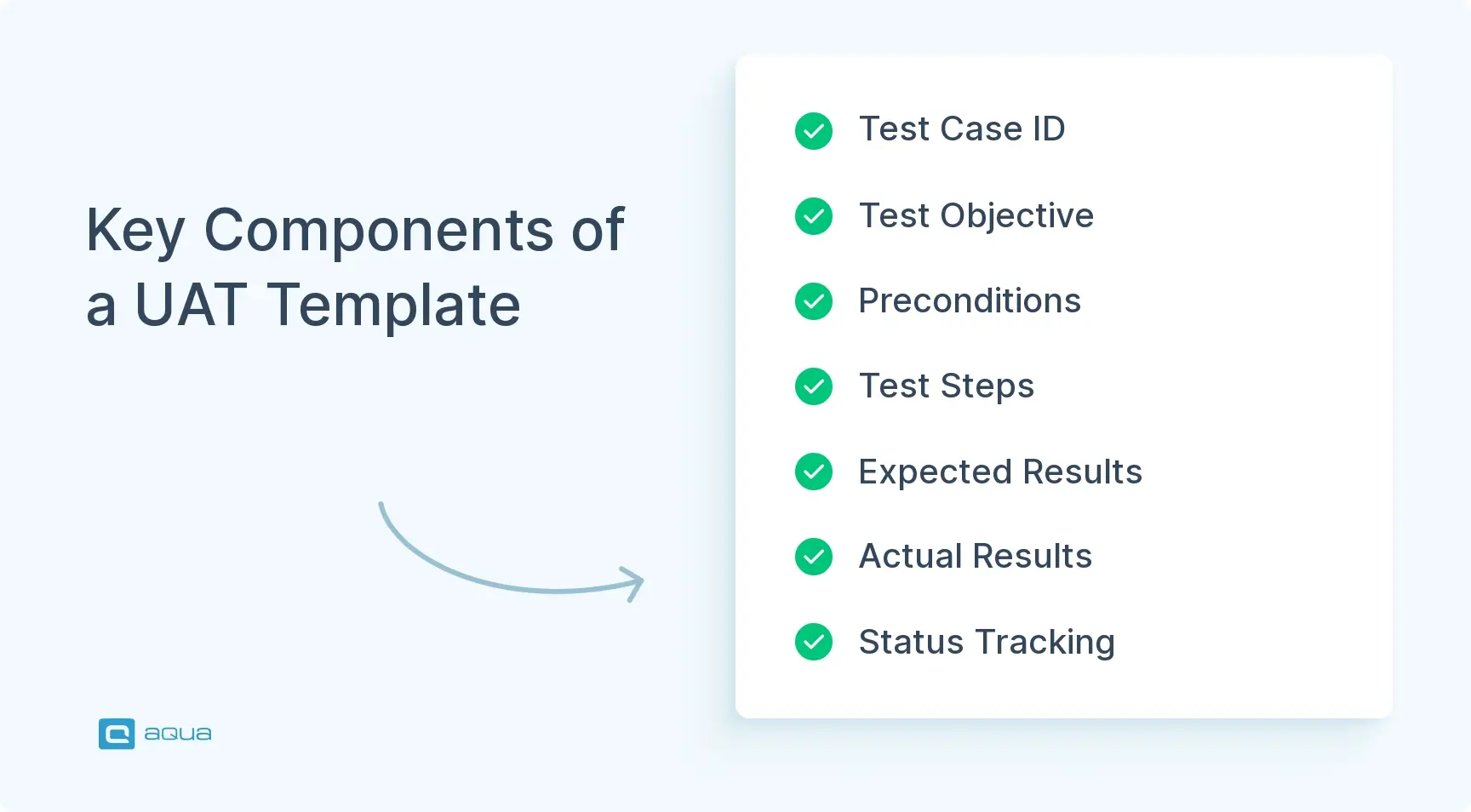Important scenarios get overlooked. Valuable feedback disappears into scattered documents. UAT templates transform this process into systematic validation that protects both users and development teams from costly post-release surprises. And we will teach you how to build a killer UAT template in this article.
What is the User Acceptance Testing (UAT) template?
A user acceptance testing template provides standardised frameworks for conducting acceptance testing. But why does this matter? Because without structure, UAT becomes a free-for-all where critical scenarios get missed.
These templates typically include test scenarios, step-by-step procedures, expected results, and spaces to record actual outcomes. Think of them as your testing roadmap. They ensure nothing important gets overlooked while creating documentation that stakeholders can actually understand and review.
What makes UAT testing templates particularly valuable is their adaptability. Are you testing a mobile app? The template focuses on touch interactions and device-specific scenarios. Working on enterprise software? The template emphasises complex workflows and integration points. The framework stays consistent, but the content adjusts to match what you’re actually testing.
Templates also solve the accountability problem. Who ran this test? When was it completed? What were the actual results? Without uat sample templates, this information gets scattered across emails, chat messages, and people’s memories. With templates, everything gets documented systematically.
The real benefit, however, is consistency. Templates prevent you from making up testing approaches on the fly. Instead, every testing cycle follows the same systematic method. This makes results more reliable and lets you compare outcomes across different releases or projects.
So how do you actually build templates that work for your specific situation? Let’s start with the components.
Components of a UAT Template
Building an effective UAT template requires balancing structure with practical usability. Too much structure creates bureaucracy. Too little creates chaos. Here are the components that actually matter for productive testing.
- Test Case ID: Every test needs a unique identifier like UAT-001 or USER-LOGIN-01. Why? Because you’ll need to reference specific tests in meetings, bug reports, and status updates. Simple numbering systems work better than complex coding schemes.
- Test Case Title: Write titles that instantly communicate what’s being tested. “Login functionality” is vague. “User login with valid credentials via email address” tells testers exactly what to focus on.
- Test Objective: Explain the purpose behind each test. What are you trying to verify? This helps testers understand the context and make better judgment calls when unexpected situations arise.
- Preconditions: List any acceptance criteria that must be met before testing begins. “User must be logged in” or “Database must contain sample customer records” prevents testers from wasting time on impossible scenarios.
- Test Steps: Provide step-by-step instructions that guide testers through the exact process. Make steps specific enough that different testers would perform them consistently. Avoid assumptions about user knowledge or system familiarity.
- Expected Results: Define what should happen if the software works correctly. Be specific about what testers should see, hear, or experience. Vague expectations lead to inconsistent interpretations of test outcomes.
- Actual Results: Create space for testers to record what actually happens during testing. This becomes critical documentation when results don’t match expectations or when patterns emerge across multiple test cycles.
- Status Tracking: Include simple status indicators like Pass, Fail, or Not Tested. Some teams add Blocked for situations where testing can’t proceed due to external factors.
- Comments and Notes: Provide space for additional observations, context, or issues that don’t fit elsewhere. Often the most valuable insights come from tester observations that fall outside formal test parameters.
- Severity and Priority: When issues arise, classification helps teams make decisions about what must be fixed immediately versus what can wait for future releases.
- Tester Information: Document who performed the test and when. This creates accountability and helps teams follow up on questions or clarifications about specific test results.
- Sign-off Section: Include a space where stakeholders can formally approve test results. This creates clear decision points and prevents disputes about what was actually tested and accepted.

The goal isn’t perfect documentation. It’s creating a framework that guides systematic testing while capturing the information your team needs to make informed decisions about software readiness.
Testing templates are essential for structured UAT, but maintaining and optimising these templates often becomes a time-consuming challenge. This is where a dedicated acceptance testing tool like aqua cloud transforms your approach to UAT. With aqua’s AI-powered capabilities, you can instantly generate comprehensive UAT templates tailored to your specific requirements, saving hours of manual template creation. The platform’s intuitive interface allows both technical and non-technical stakeholders to participate in the testing process, ensuring your software truly meets real-world user expectations. Instead of starting from scratch with each new project, aqua’s centralised repository lets you store, reuse, and refine your most effective UAT templates. Plus, with built-in traceability between requirements and test cases, you’ll always have documentation showing exactly what’s been tested and approved. To top it all, aqua provides integrations with the most popular frameworks like Jira, Confluence, and Azure DevOps.
Transform your UAT process with templates that practically write themselves
Examples of UAT Templates
Different projects need different levels of detail. Here are three template approaches that work for various team sizes and project complexity levels.
Basic UAT Test Case Template
This straightforward format works well for smaller projects or teams new to formal testing processes.
| Test Case ID | TC-001 |
|---|---|
| Test Case Title | User Registration |
| Description | Verify that new users can successfully register for an account |
| Preconditions | 1. Application is accessible 2. Registration page is available |
| Test Steps | 1. Navigate to the registration page 2. Enter a valid username 3. Enter a valid email 4. Create and confirm password 5. Click the “Register” button |
| Expected Result | User account is created and confirmation email is sent |
| Actual Result | [To be filled during testing] |
| Status | [Pass/Fail] |
| Comments | [Any observations] |
| Tested By | [Tester name] |
| Date | [Test date] |
The basic template captures essential information without overwhelming new testers. It focuses on core testing elements while keeping documentation manageable.
Comprehensive UAT Testing Template
Complex enterprise applications often require more detailed tracking and documentation. This expanded format handles those requirements.
| Field | Details |
|---|---|
| Project Name | [Project name] |
| Test Case ID | UAT-[module]-[number] |
| Test Case Version | [version number] |
| Test Category | [Functional/UI/Performance/Security] |
| Requirement Reference | [Requirement ID] |
| Test Priority | [High/Medium/Low] |
| Test Title | [Brief description] |
| Detailed Description | [Full explanation of what’s being tested] |
| Preconditions | [List all necessary preconditions] |
| Test Data | [Specific test data required] |
| Test Steps | [Numbered step-by-step instructions] |
| Expected Results | [Detailed expected outcomes] |
| Actual Results | [To be completed during testing] |
| Status | [Pass/Fail/Blocked/Not Tested] |
| Defect ID | [If applicable, link to defect report] |
| Severity | [Critical/High/Medium/Low] |
| Tester | [Name] |
| Test Date | [Date] |
| Test Environment | [Dev/QA/Staging] |
| Screenshots | [Links or attachments] |
| Notes | [Additional observations] |
| Approved By | [Stakeholder name] |
| Approval Date | [Date] |
This comprehensive approach provides extensive traceability and documentation that enterprise environments typically require for compliance and audit purposes.
Scenario-Based UAT Template
This template focuses on complete user journeys rather than individual functions. It works particularly well for testing complex workflows.
| Scenario ID | S-001 |
|---|---|
| Scenario Name | Complete Purchase Flow |
| Business Process | E-commerce transaction |
| Users/Roles | Regular customer |
| Scenario Description | Verify that users can browse products, add items to cart, and complete checkout |
| Acceptance Criteria | 1. Product selection functions correctly 2. Cart updates accurately 3. Checkout process completes successfully 4. Order confirmation is displayed 5. Confirmation email is received |
| Test Cases | TC-101: Product browsing and selection TC-102: Shopping cart functionality TC-103: Checkout process TC-104: Order confirmation |
| Dependencies | Payment gateway integration |
| Test Data | Test credit card numbers, sample user accounts |
| Overall Status | [Complete/In Progress/Not Started] |
| Signed Off By | [Name] |
| Sign-Off Date | [Date] |
Scenario-based templates help teams test complete business processes rather than isolated features. This approach often catches integration issues that single-function testing misses.
Choose the template format that matches your project complexity and team experience. Start simple and add complexity only when it provides genuine value to your testing process.
Steps to Implement UAT Templates
Implementing UAT templates requires systematic execution that builds on proper planning. Here’s a user acceptance testing process template that transforms good intentions into reliable results.
1. Define UAT Objectives and Scope
Start by identifying what you’re actually testing and why it matters. Work with stakeholders to determine which features need validation and what constitutes acceptable performance. Document these objectives clearly using a comprehensive UAT document template to guide testing efforts and prevent scope creep during execution.
2. Identify and Recruit UAT Participants
Select testers who represent your actual end users rather than whoever happens to be available. Consider internal business users, client representatives, external customers for beta testing, and subject matter experts who understand business context and have stakes in the software’s success.
3. Develop the UAT Plan
Create a comprehensive user acceptance testing plan that addresses testing timelines and milestones, roles and responsibilities, test environment requirements, entry and exit criteria, risk assessment strategies, and communication protocols. This plan becomes your roadmap throughout the entire UAT process.
4. Create UAT Test Cases
Develop detailed test cases using your chosen UAT testing template format. Each test case should align with business requirements, cover critical user journeys, include both positive and negative scenarios, and remain clear enough for non-technical users to follow. A well-structured UAT document template helps ensure consistency across all test cases. Focus on real-world usage patterns rather than edge cases or technical testing scenarios.
5. Prepare the Test Environment
Set up stable testing environments that closely resemble production conditions. Install the latest software builds, load realistic test data, configure necessary integrations, and ensure all testers have appropriate access permissions. The environment should be isolated enough to prevent interference with other systems while remaining realistic.
6. Conduct UAT Training
Before testing begins, train UAT participants on the testing purpose and scope, how to use the testing environment effectively, how to document results using your UAT form templates properly, and the process for reporting and escalating issues. This training ensures consistent, high-quality testing results across all participants.
7. Execute Test Cases
During the testing phase, follow established schedules, encourage comprehensive documentation, hold daily check-ins to discuss progress and blockers, and keep technical support available to assist testers. Maintain centralised locations for all test documentation and results to prevent information from getting scattered.
8. Track Defects and Manage Issues
Implement clear processes for reporting defects, prioritising issues, tracking fixes, and retesting resolved problems. This cycle continues until all critical issues are resolved and the software meets established acceptance criteria.
9. Analyse Results and Make Go/No-Go Decisions
Once testing completes, compile and analyse all test results, review outstanding issues and their severity levels, compare results against acceptance criteria, and make informed decisions about software release readiness. This often involves formal sign-off meetings with key stakeholders.
10. Create UAT Sign-Off Documentation
Document final UAT results, including summaries of completed testing, test coverage statistics, known issues and their severity levels, and formal approval from authorised stakeholders. This documentation serves as the official record of UAT completion and approval for future reference.
Each step builds on the previous one, creating a systematic approach that reduces the chaos typically associated with user acceptance testing while ensuring thorough validation of software readiness.
UAT is what you do when you don’t involve your customers in the development process
UAT Template Checklist
Before deploying your UAT form template, verify that it includes all necessary components and functions effectively for your team’s needs.
Basic Information Requirements
- Project name and version clearly identified
- Unique test case ID and descriptive title
- Author and creation date documented
- Last updated date and version control tracking
Test Case Content
- Clear test objective that explains the purpose
- Detailed preconditions that must be met before testing
- Step-by-step test procedures that anyone can follow
- Expected results defined for each step
- Fields provided for recording actual results
- Pass/fail indicators with clear criteria
- Severity classification system for any failures
Supporting Documentation
- Test data specifications and requirements
- Environment requirements and setup instructions
- Capability for screenshots or file attachments
- Comments and notes sections for additional observations
- Defect linking capability to track issues
- Dependencies on other test cases clearly marked
Progress Tracking
- Tester identification and contact information
- Test execution date tracking
- Time tracking fields if your process requires them
- Status indicators for not started, in progress, and completed states
- Sign-off section for stakeholder approval and authorisation
Template Usability
- Clear instructions provided for testers
- Consistent formatting throughout the document
- Appropriate detail level for your team’s experience
- Compatibility with existing testing tools and systems
- Mobile-friendly design if testers use mobile devices
Industry-Specific Requirements
- Compliance requirements addressed for regulated industries
- Accessibility testing components included where applicable
- Performance metrics captured if system performance matters
- Security testing elements incorporated when security is critical
This UAT checklist template ensures your user acceptance testing form template supports successful testing processes. Whether you’re developing a comprehensive user acceptance testing plan template or a simple user acceptance testing form template, customise these requirements to match your specific project needs and organisational standards rather than including every possible element.
As we’ve seen, effective UAT templates form the backbone of successful software testing. But implementing and maintaining these templates across complex projects requires more than just good documentation. It demands a robust system that brings structure to the entire process.
aqua cloud elevates your UAT workflow by combining AI-powered template generation with comprehensive test case management. With aqua, you can invite testers to participate in your UAT cycles, while maintaining full control over who tests what. AI-powered test case, test data and requirements creation means 98% time saving. The platform’s customisable dashboards provide real-time visibility into testing progress, while the AI Copilot helps testers write better reports and identify duplicate issues. With aqua’s Chrome extension, even non-technical users can easily capture and document bugs with screenshots and recordings, ensuring nothing gets missed during UAT. All this while maintaining complete traceability from requirements to test cases to defects, giving you the confidence to make informed release decisions.
Achieve 100% UAT coverage with 70% less effort using intelligent test management
Conclusion
UAT templates turn testing chaos into organised validation that catches problems before users see them. Structure helps, but don’t overdo it. Your template should guide testers without burying them in paperwork. Keep it practical for people who aren’t testing experts. Review your templates regularly because what works for one project might not work for the next. The point isn’t creating perfect documentation. It’s shipping software that actually works for the people using it.


















